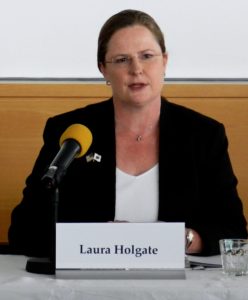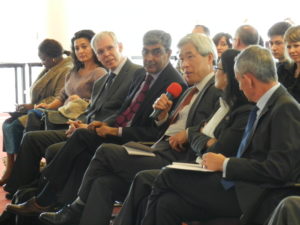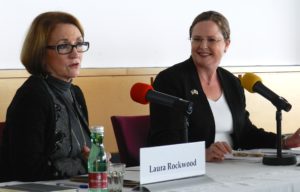

On 7 October 2016, the VCDNP hosted a public seminar that featured US Ambassador Laura S.H. Holgate, who discussed the future of nuclear security after the conclusion of the Nuclear Security Summit Process. This seminar was also part of the VCDNP’s biannual Nuclear Non-Proliferation and Disarmament intensive short course for diplomats and practitioners.
Ambassador Holgate explained how President Obama had developed the concept of the Summits during his first campaign for presidency. Obama realized that there was no venue for discussing threats to nuclear security among heads of state and government. From the beginning, his idea was to strengthen the institutions dealing with nuclear security. In this regard, the Summits were never intended to be an indefinite process. Their purpose was to create the political will to address issues that had been raised since what Ambassador Holgate defined the “first nuclear security summit”, held in Moscow in 1996. Its declaration, Ambassador Holgate commented, was remarkably similar to the communique released 20 years later at the conclusion of the final Nuclear Security Summit.
Ambassador Holgate highlighted some of the results of the Nuclear Security Summit Process. The creation of a diverse Sherpa community, empowered to work collectively to put pressure on national bureaucracies, “allowed us to get a lot done”, to use the Ambassador’s words. To a certain extent, the “Sherpa family” will live on—with an expanded membership—in the Nuclear Security Contact Group, which will convene on the margins of nuclear security-related fora, including (but not limited to) the International Atomic Energy Agency (IAEA). Another significant contribution of the Nuclear Security Summits was pushing forward the entry into force of the amendment to the Convention on the Physical Protection of Nuclear Material (CPPNM).
These achievements alone reveal the important role that the IAEA will play in the future. No one questions the Agency’s centrality in the nuclear security architecture anymore. While Vienna will become the center of gravity for nuclear security, it will not be the only venue where the issue will be discussed. However, the Ambassador emphasized that nuclear security should become a more frequent item on the agenda of the Board of Governors. IAEA-sponsored peer reviews and capacity‑building measures in the field of nuclear security should also be strengthened. But perhaps the most important aspect, according to Ambassador Holgate, is that nuclear safety and security are critical enablers of peaceful uses of nuclear energy.

Before concluding her presentation, Ambassador Holgate briefly mentioned that the US government strongly hoped that the ministerial segment of the IAEA’s International Conference on Nuclear Security in December would be attended by a significant number of high-level representatives from Member States. During the conference, the United States plans to present its latest domestic progress in the area of nuclear security, and it hopes that other countries would follow suit. Ambassador Holgate was personally looking forward to the conference’s interactive session, which would revolve around scenarios of hypothetical challenges, including, for example, how threats (and responses) would change now that the CPPNM amendment is in force.
In her final remarks, Ambassador Holgate stressed that, although much has been accomplished to mitigate nuclear security risks, threats still persist. She highlighted that there was a wide range of circumstances in which nuclear terrorism could occur, and mentioned risks posed by drones, cyber‑attacks and dirty bombs. Nuclear security efforts cannot control the ideology or technical capabilities of terrorist groups, but they can reduce the chance that they could get access to radiological and nuclear materials. Another way to resist and prevent these attempts is to educate the public about the nature of the threat in order to limit panic and fear. In this regard, Ambassador Holgate highlighted that the Nuclear Security Contact Group will engage with civil society and industry, as these communities are also part of the nuclear security architecture.

During the question and answer session, Ambassadors from the “Vienna community” took the floor to voice their concerns and express their thoughts on the future of nuclear security. Moderator and VCDNP Executive Director Laura Rockwood asked Ambassador Holgate to comment on the nuclear security resolution that was adopted during the latest IAEA General Conference. The Ambassador welcomed the adoption by consensus of the resolution as a positive change, but was frustrated that too much time had been spent on preambles on disarmament language that would not affect the work of the IAEA in any way. The Ambassador stated that the US government is committed to nuclear disarmament and is looking for partners to follow the same path. On the issue of military materials, Ambassador Holgate noted that those advocating for further transparency need to be clearer about the nature of the information they seek and the benefits that the countries offering that information would receive as a result. The information disclosed by the US government is a product of US political culture; expectations of other nuclear-weapon states need to be mindful of their political cultures, and be targeted to fit within them.